Input interpretation

trimethylamine
Chemical names and formulas
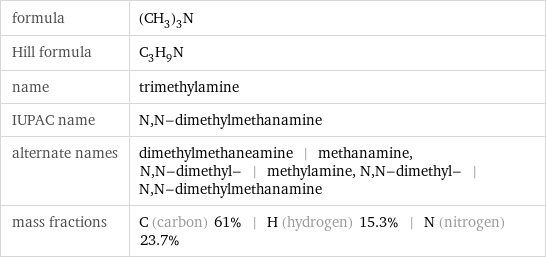
formula | (CH_3)_3N Hill formula | C_3H_9N name | trimethylamine IUPAC name | N, N-dimethylmethanamine alternate names | dimethylmethaneamine | methanamine, N, N-dimethyl- | methylamine, N, N-dimethyl- | N, N-dimethylmethanamine mass fractions | C (carbon) 61% | H (hydrogen) 15.3% | N (nitrogen) 23.7%
Lewis structure
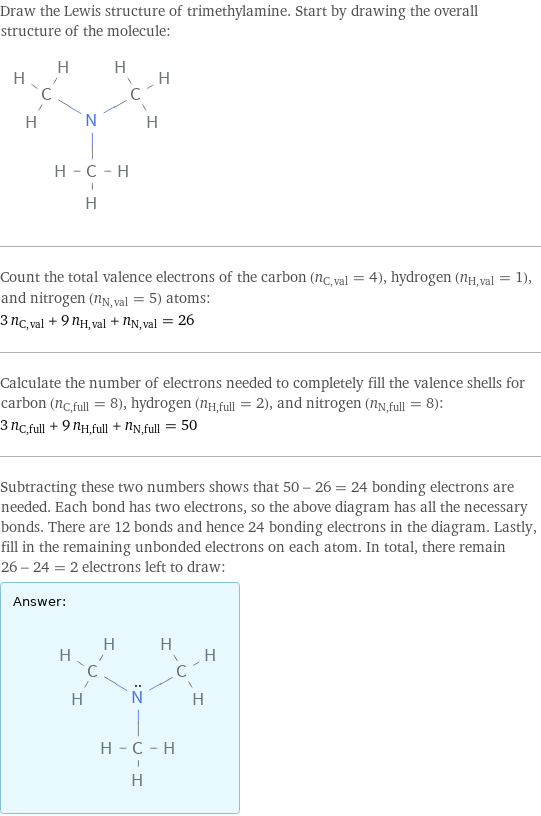
Draw the Lewis structure of trimethylamine. Start by drawing the overall structure of the molecule: Count the total valence electrons of the carbon (n_C, val = 4), hydrogen (n_H, val = 1), and nitrogen (n_N, val = 5) atoms: 3 n_C, val + 9 n_H, val + n_N, val = 26 Calculate the number of electrons needed to completely fill the valence shells for carbon (n_C, full = 8), hydrogen (n_H, full = 2), and nitrogen (n_N, full = 8): 3 n_C, full + 9 n_H, full + n_N, full = 50 Subtracting these two numbers shows that 50 - 26 = 24 bonding electrons are needed. Each bond has two electrons, so the above diagram has all the necessary bonds. There are 12 bonds and hence 24 bonding electrons in the diagram. Lastly, fill in the remaining unbonded electrons on each atom. In total, there remain 26 - 24 = 2 electrons left to draw: Answer: | |
3D structure
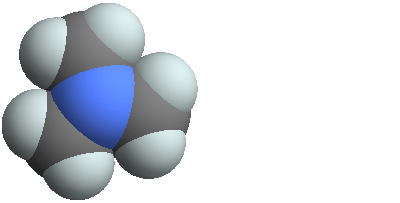
3D structure
Basic properties

molar mass | 59.11 g/mol phase | gas (at STP) melting point | -117 °C boiling point | 3.5 °C density | 0.63 g/cm^3 (at 20 °C)
Units

Gas properties (at STP)
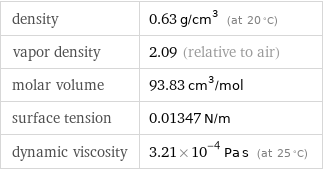
density | 0.63 g/cm^3 (at 20 °C) vapor density | 2.09 (relative to air) molar volume | 93.83 cm^3/mol surface tension | 0.01347 N/m dynamic viscosity | 3.21×10^-4 Pa s (at 25 °C)
Units

Thermodynamic properties
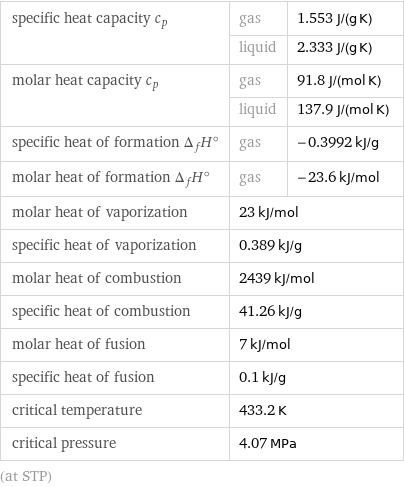
specific heat capacity c_p | gas | 1.553 J/(g K) | liquid | 2.333 J/(g K) molar heat capacity c_p | gas | 91.8 J/(mol K) | liquid | 137.9 J/(mol K) specific heat of formation Δ_fH° | gas | -0.3992 kJ/g molar heat of formation Δ_fH° | gas | -23.6 kJ/mol molar heat of vaporization | 23 kJ/mol | specific heat of vaporization | 0.389 kJ/g | molar heat of combustion | 2439 kJ/mol | specific heat of combustion | 41.26 kJ/g | molar heat of fusion | 7 kJ/mol | specific heat of fusion | 0.1 kJ/g | critical temperature | 433.2 K | critical pressure | 4.07 MPa | (at STP)
Chemical identifiers
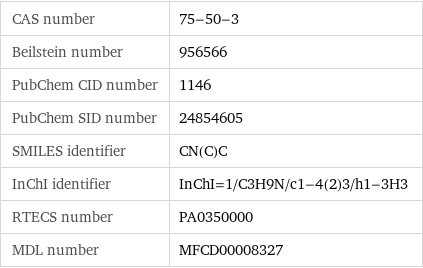
CAS number | 75-50-3 Beilstein number | 956566 PubChem CID number | 1146 PubChem SID number | 24854605 SMILES identifier | CN(C)C InChI identifier | InChI=1/C3H9N/c1-4(2)3/h1-3H3 RTECS number | PA0350000 MDL number | MFCD00008327
NFPA label

NFPA label
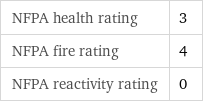
NFPA health rating | 3 NFPA fire rating | 4 NFPA reactivity rating | 0
Safety properties
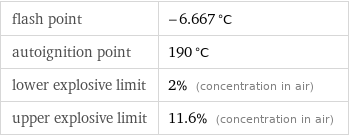
flash point | -6.667 °C autoignition point | 190 °C lower explosive limit | 2% (concentration in air) upper explosive limit | 11.6% (concentration in air)

DOT hazard class | 2.1 DOT numbers | 1297
Toxicity properties

short-term exposure limit | 36 mg/m^3

long-term exposure limit | 24 mg/m^3 (over 8 hours) RTECS classes | reproductive effector